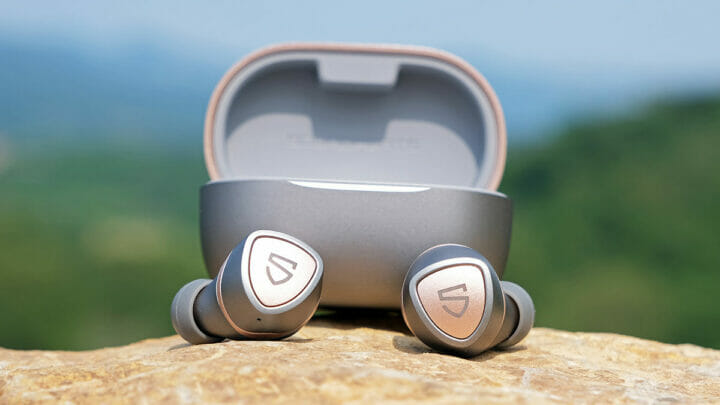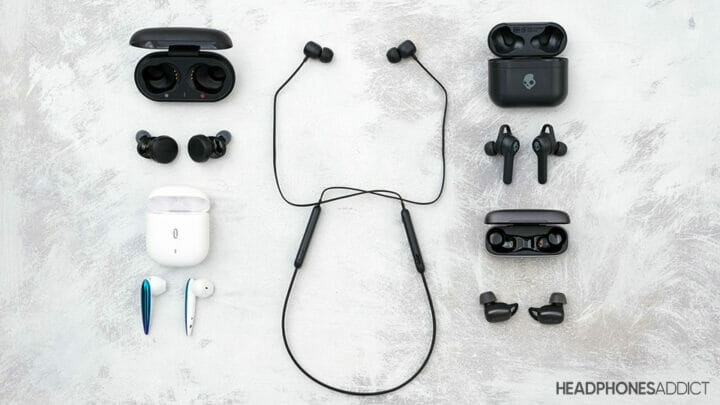You should use the right ear tips for optimal sound quality, noise isolation, and comfort.
And here’s everything you need to know about ear tips and how to choose them to get the best fit with your earbuds.

Picking the right ear tips is essential.
Many people often find in-ear headphones or earbuds uncomfortable or sounding worse than full-sized headphones. However, most of these problems occur due to improper fit and seal.
People have different ear canals with different lengths, shapes, and openings. From an evolutionary standpoint, our ears amplify frequency regions associated with human speech.
But not all people amplify the same frequencies. That’s why some people find the same headphones peaky and sibilant, while others find them to sound perfectly fine.
Let’s dig in:
What Are the Best Ear Tips for You? (Quick Guide)
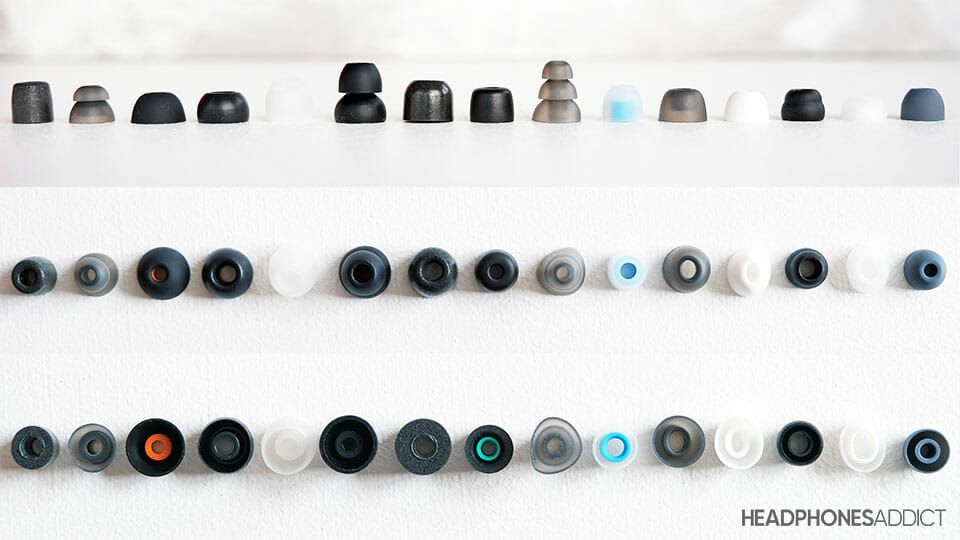
Ask yourself the following questions:
Do I prefer stability or comfort?
Stability is essential if you’re working out or running and need perfectly stable earbuds that won’t fall out.
- Pick bigger, tighter-fitting ear tips that create more pressure in your ears. But this might make them less comfortable after some time.
Comfort is preferable for prolonged listening during work, commutes, or just for fun.
- Pick looser fitting ear tips and preferably made from memory foam for extra cushioning.
Jump to:
Am I willing to pay for optimal ear tips?
If you’re willing to pay a bit more, choose:
- Premium memory-foam ear tips (you will have to replace them more often)
- Or go all out on custom ear tips (the most expensive)
If you don’t want to spend money, stick with:
- Silicone ear tips (that you get in the box, so they’re free and the most durable)
7 Types of Ear Tips

What are all the different types, materials, and designs of ear tips?
Find the answers below, but first…
A quick comparison of the 5 main ear tip types you need to know about:
| Type of ear tips | Durability | Comfort | Stability | Noise Isolation | Price |
|---|---|---|---|---|---|
| Silicone | High | Medium | Lesser | Medium | Cheap |
| Memory foam | Low | Excellent | Superior | Great | Reasonable |
| Hybrid | Medium | Medium+ | Lesser+ | Medium+ | Affordable |
| Multi-flanged | High | Lower | Lesser | Great | Affordable |
| Custom-made | High | Superior | Superior | Superior | Expensive |
Let’s check the details of all the different ear tip materials:
1. Silicone ear tips
Silicone earbud ear tips are the most common and usually come bundled with earbuds in 3 sizes (S-small, M-medium, L-large). They’re soft, durable, and the most versatile type of ear tips.
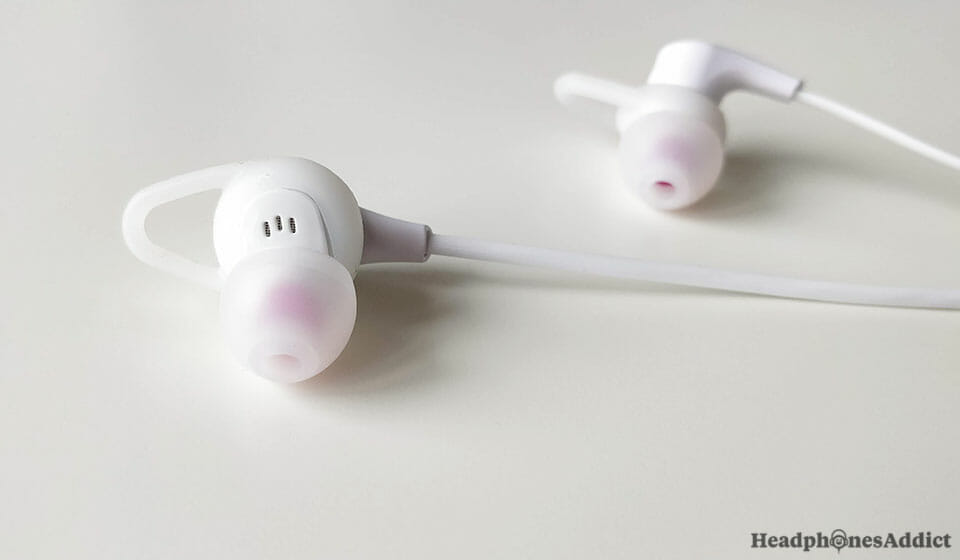
- Durable
- Medium comfort
- Cheap
- Less noise isolating
- Can be slippery
Their main strength is durability: They can last for years without any quality degradation. Silicone is a tough material that’s easy to clean. You can wash them in water and soap to make them as good as new.
Silicone ear tips offer average comfort: Soft silicone ear tips can be quite comfortable, but harder ones less so. They’re right in the middle when it comes to comfort.
Good but not great noise isolation: Regular silicone tips have enough isolating power to do a decent job. But you can get better materials for the job. Double and triple-flanged silicone ear tips offer the best passive noise isolation. You can insert them deeply, which keeps the noise away.
Slightly worse fit: Silicone ear tips aren’t the best for working out because sweat makes them slippery. And, if your ears aren’t perfectly clean of earwax, they might slip out regularly.
Overall, they provide the cleanest transition of sound from the driver to the eardrum.
You can find silicone eartips in different designs (more on that below):
2. Memory-foam ear tips
Memory-foam earbud ear tips are made from foam instead of silicone. You squeeze them to insert in your ears and they adapt to your ear canal offering superior comfort, fit, and noise isolation. But cost a bit more.
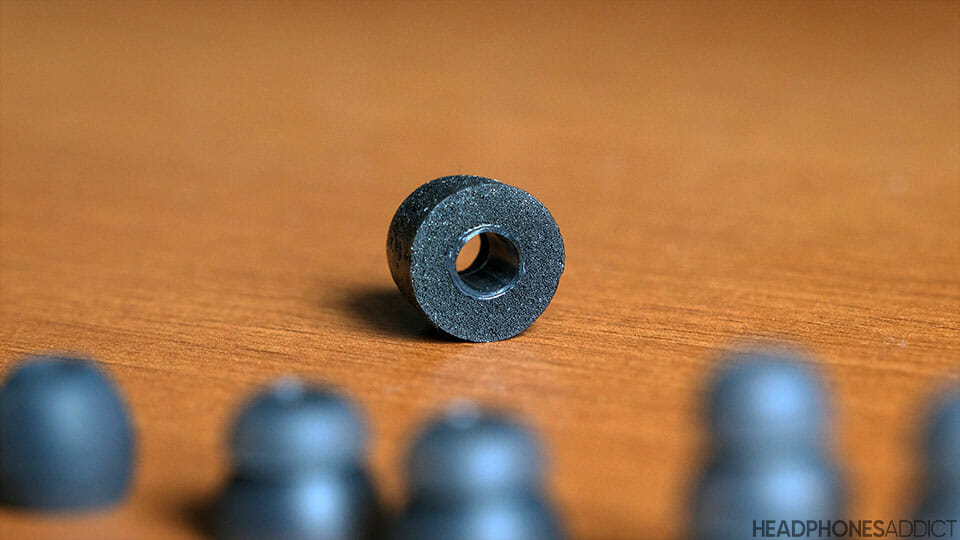
- Super comfortable & stable
- Effective noise isolation
- Less durable
- More expensive
Memory-foam ear tips are the most comfortable: Memory foam conforms to the shape of your ear canal perfectly. When you squeeze them in your ears, the foam expands and fills the whole ear canal. This balances pressure throughout the whole ear. You can listen to them for hours, even for working out, thanks to a great fit.
A slight negative is that it takes a bit more time to insert them since the memory foam has to expand, but the comfort, stability, and isolation are better.
That makes them good for working out as long as you regularly replace them. Sweat will make them deteriorate faster.
Great noise isolation: A good fit helps block more ambient noise. This also has another consequence…
Memory-foam tips noticeably change your earbuds’ sound: Sometimes for the worst, sometimes for the better. They generally increase the bass and the sound’s warmth while smoothing the treble. They are the perfect pick for harsh and sibilant in-ear monitors.
Users call this phenomenon “funneling,” and it happens because of the excess foam at the end of the tip. When inserted, that excess foam bends and covers the opening in the middle of the nozzle. Some say that slightly trimming the end of the foam tip helps.
Not the most durable: From our experience, foam tips can last at least a few months, although it depends on how often you use them and how they’re made. Some are coated with a special film to prevent earwax from building up on the tip’s surface.
But eventually, the foam ear tips get so dirty they lose their flexibility and don’t adapt to the inside of your ear the same way.
It makes sense that if you continuously squeeze the foam, it will eventually lose its shape. So, if you get foam tips, expect to replace them regularly.
3. Hybrid Ear Tips
Hybrid earbud ear tips are rare due to questionable performance. They’re usually made from a combination of silicone and memory foam and come in different shapes and colors. Some fit only specific in-ear earphones.
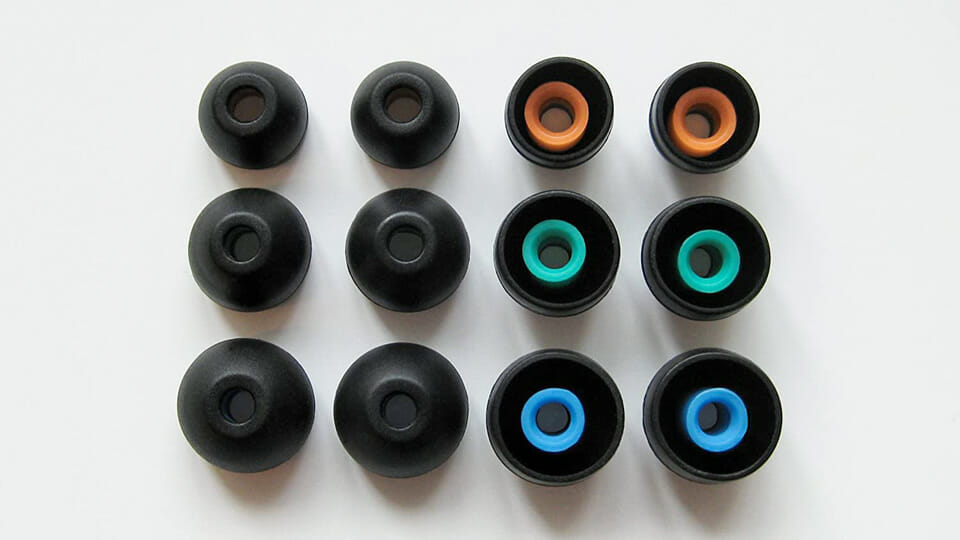
- More comfortable than silicone
- More durable than foam tips
- Don’t work for all people
- More expensive
Hybrid ear tips are uncommon but often come in a box, especially if they only fit one particular pair of earbuds.
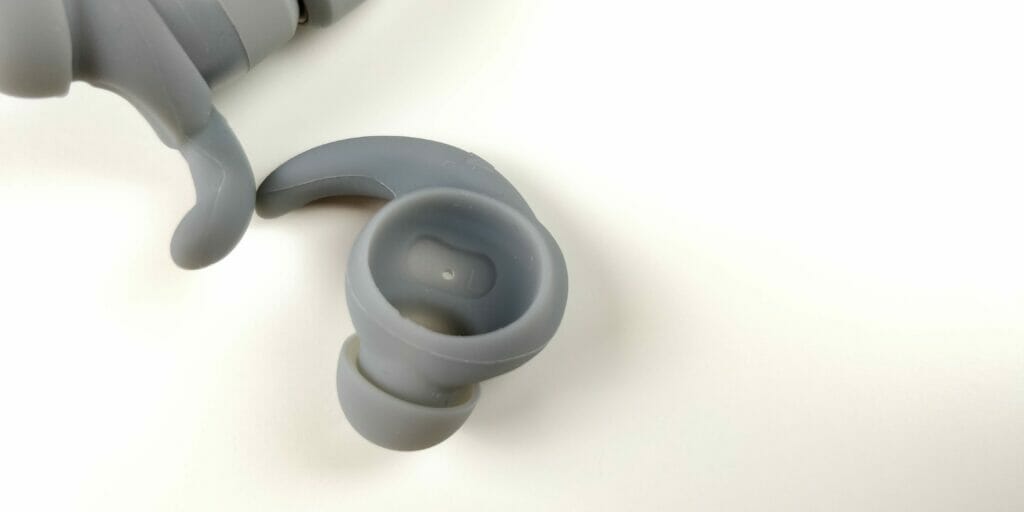
Hybrid eartips are supposed to be the middle ground between regular silicone and premium memory-foam ear tips. While some people swear by them, others don’t find them much different from existing options. This makes them dependent on personal taste and experience.
There are many different types of hybrids. In most cases, the nozzle and the outside of the ear tip are made from different materials. Or they’re stiffer/softer.
Some of the hybrid ear tips even have foam underneath the silicone cape. That ensures the sound characteristic of the silicone tip with the isolation properties of the foam ear tip.
4. Rubber ear tips
- Outdated material
- Almost non-existent
Rubber ear tips are hard to find because they’ve been replaced by softer silicone (mentioned above).
What’s the difference between rubber and silicone ear tips?
Natural rubber is made from a rubber tree, while silicone is a synthetic material. Rubber is a bit harder to the touch and not ideal for ear tips. Silicone is softer, cleaner, and allergy-free material. You will be hard-pressed trying to find natural rubber ear tips today.
Now, let’s check the different ear tip designs:
5. Multi-flanged ear tips
Double-flanged and triple-flanged earbud ear tips have 2 or 3 flanges instead of 1 in regular ear tips. The difference in design helps improve passive noise isolation and fit more deeply into the ear canal. They’re most common for in-ear monitors.
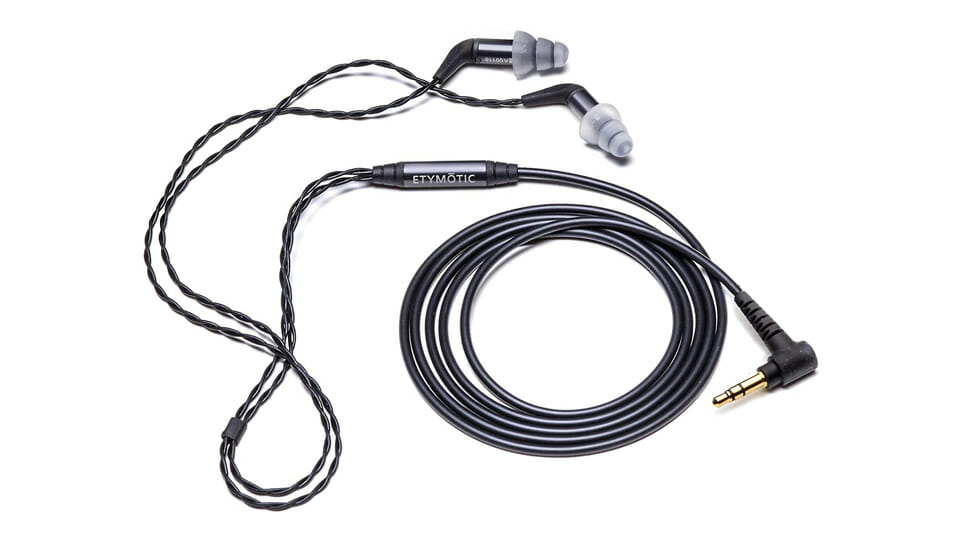
- Great noise isolation for silicone
- As durable as silicone
- Have to buy them seperately
- A bit uncomfortable
The best durable option when you need great noise isolation: Multi-flanged silicone ear tips sometimes come with earbuds, but you usually have to buy them separately. They offer superior passive noise isolation and are especially popular among professional users wearing in-ear monitors.
There are bi-flanged and triple-flanged ear tips. They also prevent water from coming inside your ears, so they often come with waterproof headphones for swimming.
Comfort suffers: The biggest problem is that you must push them deeper inside your ear canal, especially the triple-flange ones. For beginners, the insertion procedure can be uncomfortable. It creates an airtight environment inside the ears that feels like a suction.
Don’t pull them out of your ear too quickly since the pressure can damage your eardrums. While the weird sensation is something that you get used to, you still have to be careful.
6. Custom ear tips
Custom earbud ear tips are made specifically to fit your ear canal shape. They’re the most expensive option but offer the best fit and isolation.

- Great comfort & fit
- Superior noise isolation
- The most expensive
- Require some effort to get them
Custom tips are the best way to ensure ultimate comfort and fit since every ear canal is unique. Custom tips require you to make a cast of your inner ear. That is usually done by a hearing aid professional (you can order a custom tip at the medical shop).
It takes time: But there is a catch, you need to give them your IEMs. In a matter of weeks, they will make personalized ear tips just for you, with your IEMs inside the custom tip.
Some audio companies allow you to create a cast of your own, as they send you the putty to make an impression of your ear. There are also DIY options if you’re a crafty type. But those don’t guarantee good results.
Pricey: All of this costs money. You can easily pay over $50 for a pair of custom-made ear tips.
Getting custom-made ear tips is worth only to the most passionate in-ear audiophiles who are willing to go through all money and effort obstacles to improve comfort and fit.
7. Foam covers
Foam covers for earphones that don’t go in the ear are technically not ear tips but have a similar function. They improve the comfort and fit of your non-in-ear earbuds.
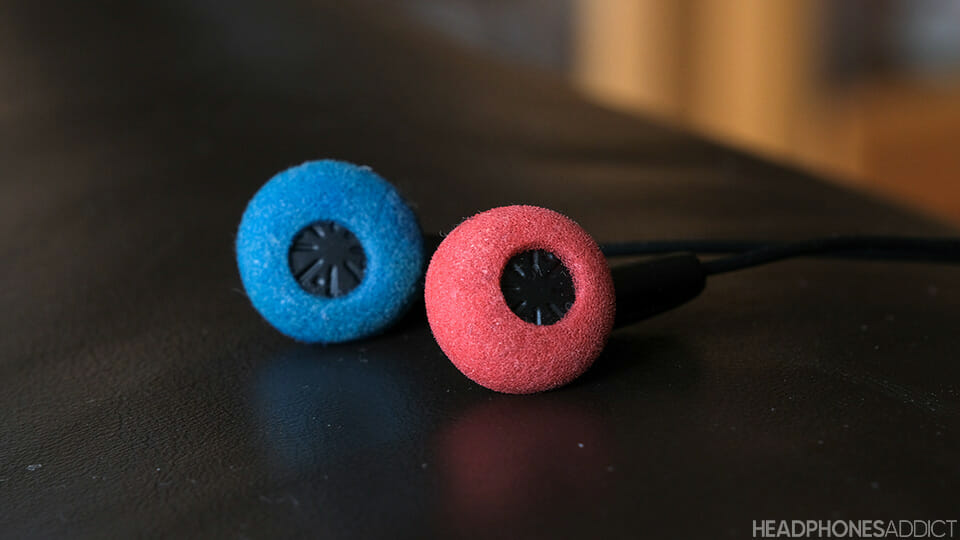
- Improve earphone comfort & fit
- Short lifespan
Foamy covers improve comfort and stability. Bare plastics in classic earbuds that don’t go in ear becomes slippery when sweating. The foam covers elegantly solve this problem and are still popular today.
Usually, they cover the whole earphone, while others have a hole in the middle of the bud. Apart from providing a comfortable fit, they can also change the sound quality, primarily reducing treble peaks.
Foam covers are fragile and tear up quickly. That is why you need to handle them with care, especially during the installation process.
For more info on specific brands and characteristics of ear tips, there is an extensive test here.
Comparison of memory foam vs. silicone ear tips
Memory foam and silicone have their own advantages and disadvantages. Choosing between the two comes down to personal preference.
Here’s a quick comparison of memory foam vs. silicone ear tips:
| Category | Memory foam | Silicone |
|---|---|---|
| Comfort | More comfortable | Less comfortable |
| Stability | More stable | Somewhat slippery |
| Noise isolation | Great noise isolation | Medium noise isolation |
| Durability | Less durable | More durable |
| Price | Usually have to buy them | Free or cheap |
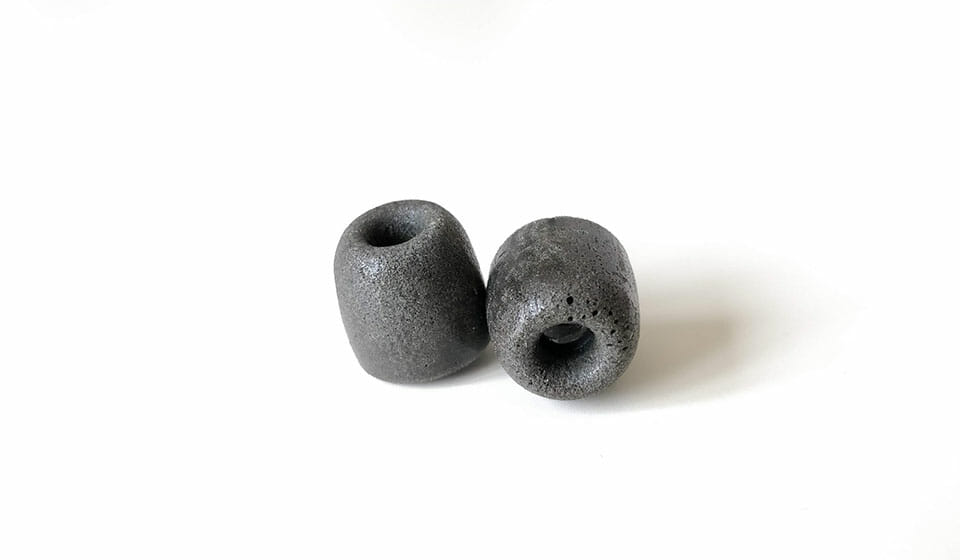
Are memory foam or silicone eartips better for working out?
Memory foam eartips conform to the shape of your ear canal, providing a tight and stable fit. They’re the best choice for active people who need earbuds to stay snug and secure during a workout or run.
On the other hand, silicone eartips often become slippery and fall out when wet. So, they’re not the optimal choice for active users.
Which is more comfortable and blocks more noise?
Memory foam ear tips are more comfortable than silicone. The softer foam is easier on the ears than silicone, creating a more pleasant wearing experience.
Additionally, memory foam ear tips block a lot of background noise. This is excellent in a noisy environment, especially if you use active noise cancelling earbuds.
Silicone tips offer less noise isolation, but it’s still pretty good, especially the multi-flange silicone eartips.
The only downsides of foam tips are that they might create too much pressure for people with small ear canals.
Are memory-foam eartips equally durable?
Foam tips are less durable than silicone ear tips, so you must replace them more often.
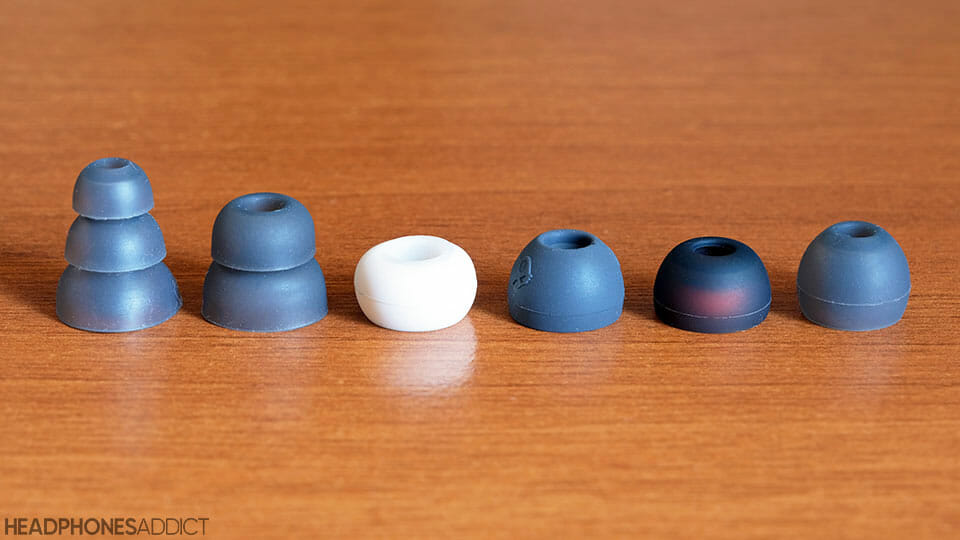
Silicone eartips are the most popular choice because they come in the box with new earbuds. They’re known for soft and flexible material that’s easy to clean.
The main advantage is that silicone eartips last longer than memory foam tips. You can use the same silicone eartips for years, while it’s typical to replace foam tips every few months.
Silicone eartips are available in multiple sizes, even extra small and extra large accommodating users with smaller and bigger ears.
What about the price?
Silicone ear tips are cheaper; you usually get them in the box with your new earbuds. Memory foam ear tips are an extra accessory. You get them with some premium in-ear headphones, but you must mostly buy them separately.
What are the Most Comfortable Earbud Ear Tips?
The most comfortable ear tips fit into your ear canal with the correct size (not too big) without creating pressure, usually of soft memory-foam type.
- Smaller ear tips are more comfortable than big ones
- Shallow-fitting ear tips are more comfortable than those that you insert deeply in the ear canal
- Memory-foam tips are comfier than silicone
If you got a bunch of ear tips to choose from with your earbuds, try the medium size first. They fit most people the best.
- Then try larger ones if the fit feels a bit loose and eartips don’t fill your whole ear canal.
- Try smaller ones if medium tips feel too tight and create pressure inside your ears.
Picking comfortable eartips is crucial for enjoying music without irritated ears. It impacts the overall listening experience and your feelings toward your earbuds.
If nothing else feels comfortable to you, then your only other option is to splurge on custom-made ear tips.
Signs of a bad fit
You purchased new in-ear headphones, but they don’t sound how other people describe them. While there is a chance the product is defective, it’s more likely ear tips don’t fit properly.
Signs of a bad eartip seal:
- Earbuds keep falling out even though you’re not moving or working out
- The sound is very thin, with little or lacking bass
- Everything sounds distant and unclear
- No noise isolation; you hear the background sound
These are the signs that you don’t use the right ear tips. Test more.
Everybody’s ear canals are unique, so finding the perfect eartips is extremely important. Slight deviations in the angle or insertion depth can change the sound signature and audio quality.
Which Type of Earbud Ear Tips is the Most Durable?
The most durable are silicone eartips which can last for years and are easy to clean. Silicone is a soft and durable synthetic material that withstands daily use and water with ease.
If you’re looking for ear tips that you won’t have to replace every couple of months like the memory foams, then silicone is your best bet.
And, if you accidentally break or lose them, they’re cheap to replace.
Memory foam tips get sticky and lose flexibility with dirt and earwax accumulation. It’s also harder to wash them successfully. Silicone tips are much easier to clean with warm water and soap, so they stay in tip-top shape.
It’s similar to ear pads, fabric pads are easy to clean, while synthetic leather has a limited lifespan due to early flaking.
What factors affect eartip durability?
- The material quality; silicone is tougher than foam
- The frequency of use
- How well do you treat your ear tips; rough handling and dirty tips deteriorate faster
Which Type of Eartips Stay in During a Workout?
Snug-fitting memory-foam ear tips stay in during a workout and physical activity the best.
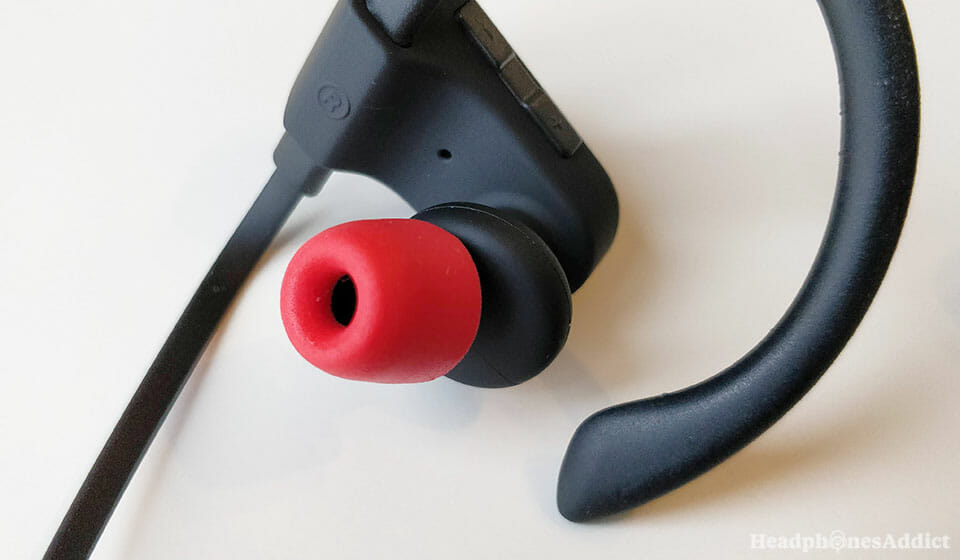
There’s nothing more annoying than trying to work out with earbuds that constantly fall out. Get the right eartips for your workout earbuds, so you can focus on your activity.
What factors affect stability in ears?
- Size: Bigger eartips create a tighter, snug fit which is more secure but less comfortable
- Material: As said before, memory foam ear tips stick in ears better than silicone which tend to slip out when sweaty
- Ear wings & hooks: These extra accessories help keep earbuds stable during extreme movement. Read about ear wings and hooks here.
While foam eartips are more secure, once they get dirty, they lose their flexibility. This makes them more likely to slip out, so replace them when needed.
Best Earbud Ear Tips Replacements
Here are the most popular eartip replacements when your old ones give out.
- Regular, medium size silicone ear tips, 10 pairs
- Comply memory foam ear tips for Beats PowerBeats
- Decibullz memory foam ear tips
- SYMBIO hybrid eartips, 3 pairs
- Triple-flange silicone ear tips, 6 pairs
Before buying, make sure the replacements fit your existing earbuds. They don’t fit all earbuds equally well.
Are Premium Ear Tips Worth It?
Premium ear tips are worth it if you care about hearing the sound details and improving the comfort of your IEMs (in-ear monitors). With a proper fit, the treble, midrange, and bass of your music will sound fuller. Low bass frequencies are especially pronounced with an airtight fit.
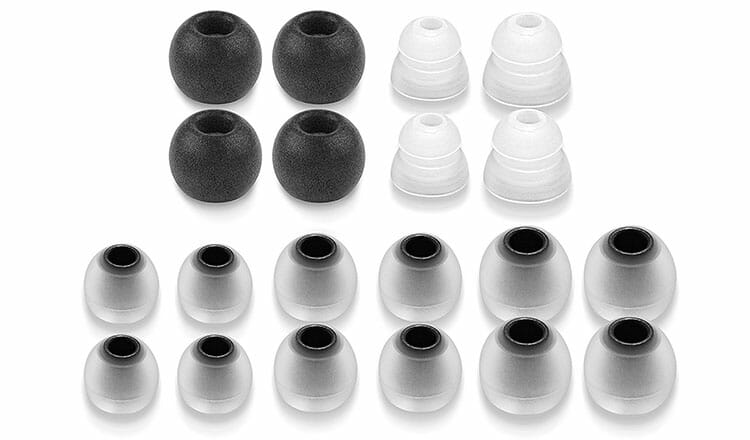
Plus, with more background noise blocked, you can focus on the audio at hand and listen at a healthier, lower volume without sacrificing enjoyment.
Premium eartips usually come in a package with a wide variety of materials and sizes. Personally, I prefer memory foam tips for sheer comfort and isolation.
If you spent over $100 for your earbuds, it’s worth spending a couple of dollars more to get the maximum performance with quality ear tips.
How to Insert & Attach Ear Tips
Using in-ear headphones isn’t as straightforward as it seems. If you want to squeeze the best user experience out of them, you should follow these directions.
Angled insertion
Lots of earbuds have slightly angled nozzles, and for a good reason. Our ear canal is not a straight hole but is instead somewhat curved up. Therefore, an angled nozzle projects the sound directly into the eardrum.
While wired earbuds are easier to insert properly, true wireless earbuds aren’t. In many cases, when inserting TWS buds, you need to place them flat in your ear, and then slightly tilt the earbuds upwards. The difference in sound can be huge, especially in treble and overall clarity.
How to insert in-ear headphones into ears
Here’s a short video demonstrating how to insert earbuds with silicone ear tips:
How to insert memory foam tips properly?
Foam tips are usually made from memory foam. Like those plugs you use when working in loud environments or during concerts, you can squeeze foam tips into an elongated shape that is slowly expanding.
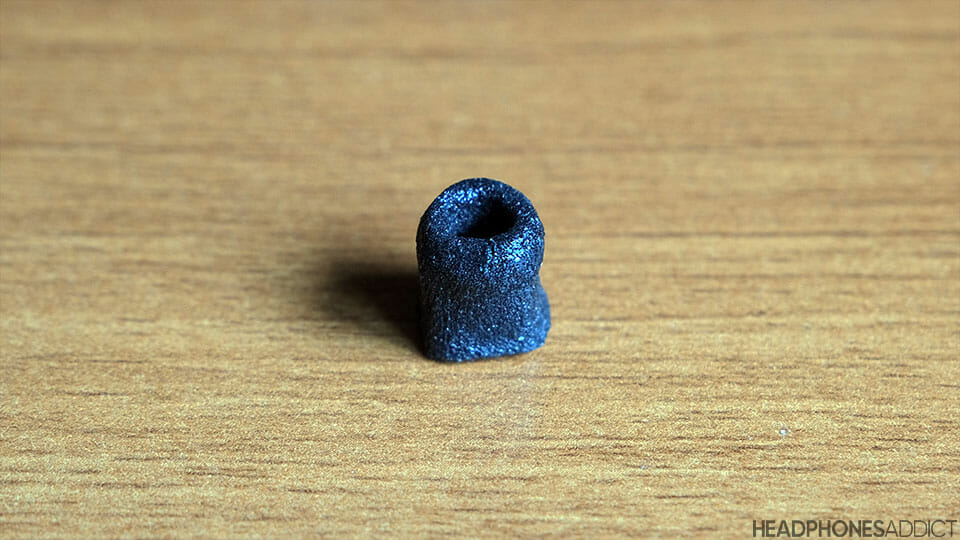
There are 3 steps to follow when inserting foam ear tips.
- First, squeeze the tips with your fingers, or roll them.
- Insert them into your ear canal into a comfortable position.
- Wait a few seconds for the foam to fully expand.
To test if the insertion was successful, place your palm across your ear. If you notice that isolation got better when doing so, you should redo the insertion.
You can wear the majority of wired in-ear monitors (IEMs) with a cable straight down. But sometimes, the housing design requires you to wear them with the wire behind your ear. If you use those IEMs in the wrong position, they can sound terrible and make your listening experience uncomfortable. If you’re not sure, check the manual to see how to wear them.
Choose the correct size
The most important thing is finding the correct size for your ear canal. Usually, you get 3 pairs of ear tips inside the box, but some might offer even more variants. Make sure you try all sizes before picking the winners. You’re looking for a good seal, that also provides optimal sound quality and comfort.

Ear tip sizes can vary between manufacturers. Some earbuds require you to push them deeper inside, while others sound best with a shallow fit. If you need them to go deep, then pick smaller size tips. If the fit is supposed to be shallow, bigger tips are a better choice.
Do ear tips fit all earbuds?
Ear tips don’t fit all earbuds the same way. There are different sizes and shapes of nozzles. Most common earbud nozzles are round and oval, like in the image below. Make sure your new ear tips fit your existing earbuds.
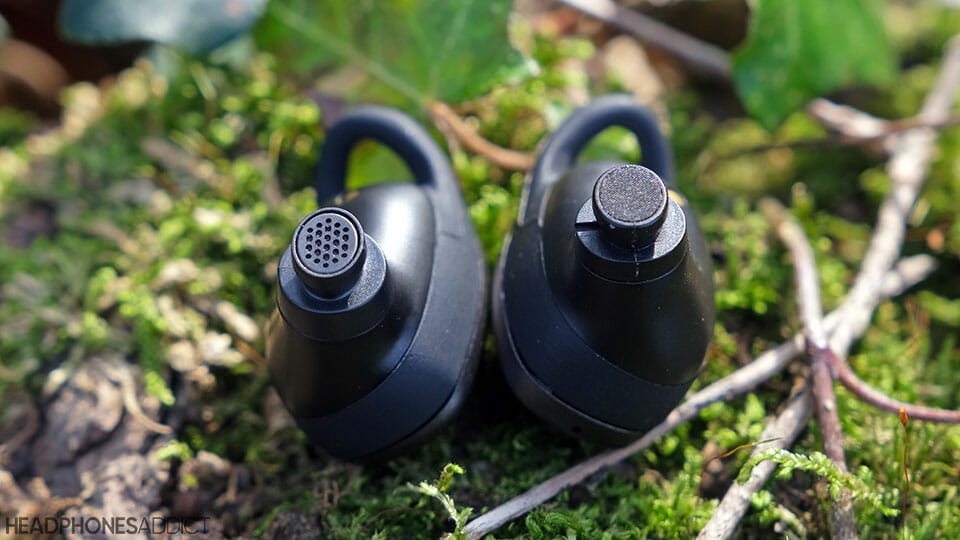
Eartips are quite flexible and can adapt to the nozzle shape if they’re big enough. But some nozzles are bigger than others.
If you have multiple IEMs at home, try removing their ear tips and compare the nozzle size between them. There is a good chance the diameters are slightly different. There is no universal standard for the nozzle size, so you need to make sure new tips are compatible with your earbuds.
Comply created 5 different size categories: from 100 to 500. They update their eartip size guide regularly, so try to find your earbuds there.
- If your earbuds are not on the list, you’ll have to contact your brand’s customer support and ask them.
- Check the ear tip’s specifications on the manufacturer’s website before buying.
- You can also just risk it and get medium-sized replacement tips. They’re likely to fit most buds.
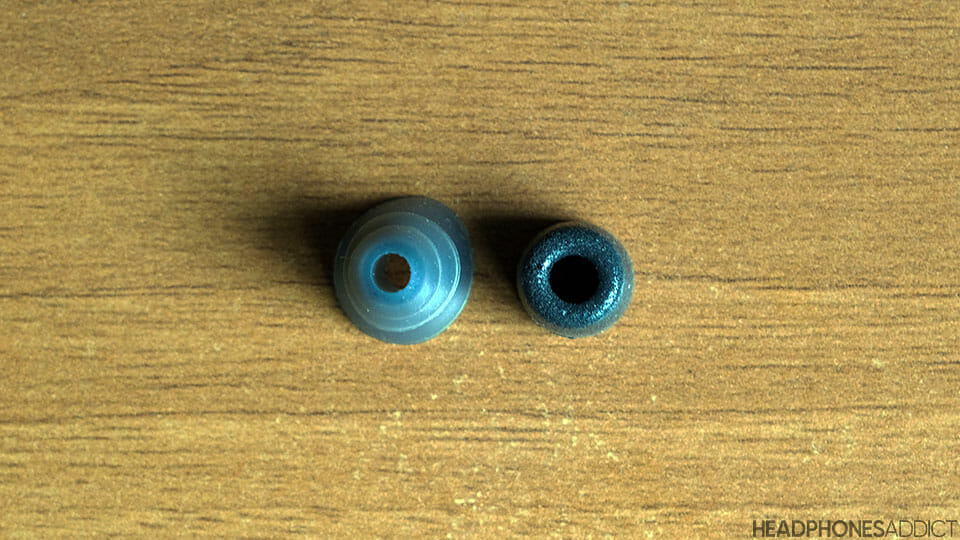
Some ear tips have narrower nozzles than the others, so it might happen that you won’t be able to fit them on your earbuds. They can also be too big, meaning that they can get stuck inside your ear canal, which can be dangerous.
How to install ear tips on your earbuds
Here’s a good video from Mackie that demonstrates how to put them on:
Is ear tip fit test software worth it?
What is ear tips fit test software?
Ear tips fit test is software that checks the quality and tightness of the eartip fit. Many brands support the feature. The most known one is probably Apple. You can check the fit of AirPods Pro on an iPhone or Apple, but not Android.

It helps you determine if you’re wearing earbuds the right way. It’s a useful feature for people who don’t know what a good fit feels like.
Is the ear tip test necessary?
The ear tip test isn’t needed for anyone who is willing to try out different eartips. The software does speed up the process, but it’s ultimately not needed.
Also, if you know how a good fit is supposed to feel, then you don’t need it.
Hygiene of your ears
Even if you do everything right, you find fantastic IEMs, get the best ear tips, and insert them properly. Sound quality can still suffer if your ears aren’t clean. Keep your ears clean of earwax for uninterrupted sonic fidelity.
Here’s an in-depth guide on how to clean earbuds.
It’s worth mentioning that people’s bodies have different reactions when wearing IEMs, especially if their bodies think that the ear tips need to be removed, resulting in increased earwax production.
Because you push IEMs into your ears, earwax is also pushed deeper into the ear canal, making it harder to clean. Cleaner ears extend your foam eartips’ life. Silicone eartips also benefit from clean ears since earwax is slippery, and slowly pushing them out of your ear canal.
FAQs
What are ear tips?
Ear tips are rubbery or foam ear plugs with a hole attached to in-ear headphones and earbuds. They provide comfort, stability, and noise isolation to the plastic earbud nozzles.
Which ear tips are best?
Generally, correctly-sized memory foam ear tips are better than regular silicone tips. And when ignoring price, the best are custom-made eartips that only fit your ear canal.
Do ear tips affect sound quality?
Ear tips affect sound quality by creating an airtight seal, boosting bass response, blocking ambient noise, and pronouncing details in the music.
Do bigger ear tips sound better?
Bigger ear tips can sound better by creating a tighter fit that boosts bass and blocks more background noise. But they can generate more pressure and be less comfortable.
How long do ear tips last?
Silicone ear tips can last a couple of years. Memory foam ear tips usually last around 6 months with regular use or longer with less frequent use.
Are foam tips better than silicone?
Foam tips are better at comfort, stability during activity, passive noise isolation, and sound but are worse in durability, lasting less than a year, and are more expensive.
How do I know which eartip size is right for me?
To know which eartip size is right for you, try different sizes and types of ear tips. The ones that feel most comfortable and sound best are the right for you.
Do AirPods come with ear tips?
Regular AirPods don’t come with ear tips. AirPods Pro come with ear tips in different sizes, so it’s easy to find the right fit for everybody.
Conclusion
Hopefully, you found this ear-tips guide useful. Most people only have to decide between silicone or memory foam ear tips. Which you choose depends on your preference.
And if you’re thinking about replacing your earbuds because you can’t get them to fit the right way. Try all the tips above and get new eartips that might just improve your earbuds into something much better.

From a childhood fascination with sound, Peter’s passion has evolved into a relentless pursuit of the finest headphones. He’s an audio expert with over 5 years of experience in testing both audiophile and consumer-grade headphones. Quote: “After many years, I can confidently tell which headphones are good and which are terrible.” Find his honest opinion in his reviews.





